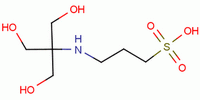- Category :
Other Chemicals/Others
- CAS NO : 29915-38-6
- EC NO : 249-954-1
- Molecular Formula : C7H17NO6S
- Main Specifications : White Powder
- Synonyms : 3-[[2-Hydroxy-1,1-bis(hydroxymethyl)ethyl]amino]-1-propanesulfonic acid; 3-[(Tris(hydroxymethyl)methyl)amino]-1-propanesulfonic acid; N-(tris(hydroxymethyl)methyl)-3-aminopropanesulfonic acid; TAPS;3-(tris(hydroxymethyl)methylamino)propane-1-sulphonic acid;N-[Tris(hydroxymethyl)methyl]-3-aminopropanesulfonic acid;3-{[1,3-dihydroxy-2-(hydroxymethyl)propan-2-yl]amino}propane-1-sulfonic acid;1-{[1,3-dihydroxy-2-(hydroxymethyl)propan-2-yl]amino}propane-1-sulfonic acid;N-[tris(hydroxymethyl)methyl]-3-amionpropanesulfonic acid;
Package: 500g/bottle
Uses : Biological buffer
Molecular Structure:

Product description:
As a necessity in biochemical experiments, the role of biological buffering agents cannot be ignored. Recently, Desheng has received many calls to consult TAPS buffer solution. As a zwitterionic ion buffering agent, its CAS number is 29915-38-6, and it is widely used in some diagnostic kits. Although there are many people who consult, there are still some who do not understand how to configure and use it, so the following will provide a detailed introduction around this aspect.
1、 Weighing TAPS powder
Calculate the relative molecular weight of TAPS based on the concentration and content of the required solution, and then analyze and calculate the required weight. Use an analytical balance for accurate weighing. During this period, it is necessary to pay attention to the purity of TAPS reagent raw materials and correct errors to avoid inaccurate experimental results due to inaccurate weighing.
2、 Dissolution of TAPS powder
According to the powder that has been weighed in the first step, pour pure water into the container for full dissolution. However, it is important to note that the initial dissolution during this process does not require the addition of excessive water, which is difficult to control. Next, proceed with the constant volume process. During the constant volume process, it is necessary to pay attention to temperature changes. As it may release or absorb heat during the dissolution process, it should be kept consistent with the room temperature. After the configuration is completed, it should be placed in a sealed bottle and stored.
3、 TAPS usage configuration
According to experimental requirements, the prepared sodium hydroxide solution can be mixed with the prepared TAPS solution in a certain proportion to obtain the required TAPS buffer solution. If the experiment requires a solution with specific acidity and alkalinity, a buffer solution with similar concentration can be prepared in proportion, and then the specific pH value can be measured using a pH meter. The ratio of the solution sodium hydroxide solution and TAPS solution can be adjusted to the desired pH value.
The buffer solution for TAPS is relatively simple to use and configure. It is recommended to purchase powdered TAPS and dissolve and configure it yourself. This is not only cost-effective, but also ensures that it can be prepared and used immediately, making it easy to store and avoiding waste of raw materials. As a manufacturer of in vitro diagnostic reagents, Desheng produces buffering agents in powder form with high purity and excellent quality. Professional personnel control the various indicators of the product, ensuring stable buffering performance and minimal impact on experimental results. If you have any requirements, please click on the website to inquire about the details!
 CN ChemNet > Gold Suppliers > Hubei new DE sheng material science and technology co., LTD. >
CN ChemNet > Gold Suppliers > Hubei new DE sheng material science and technology co., LTD. > 